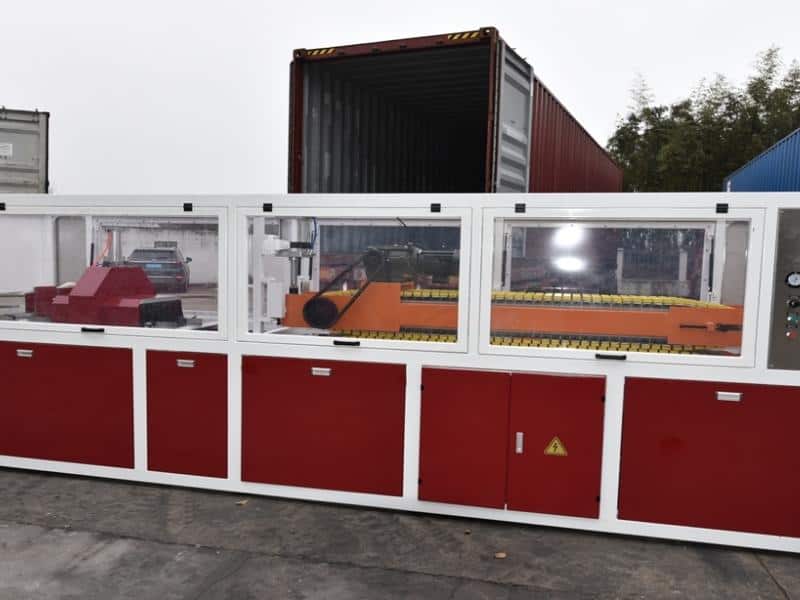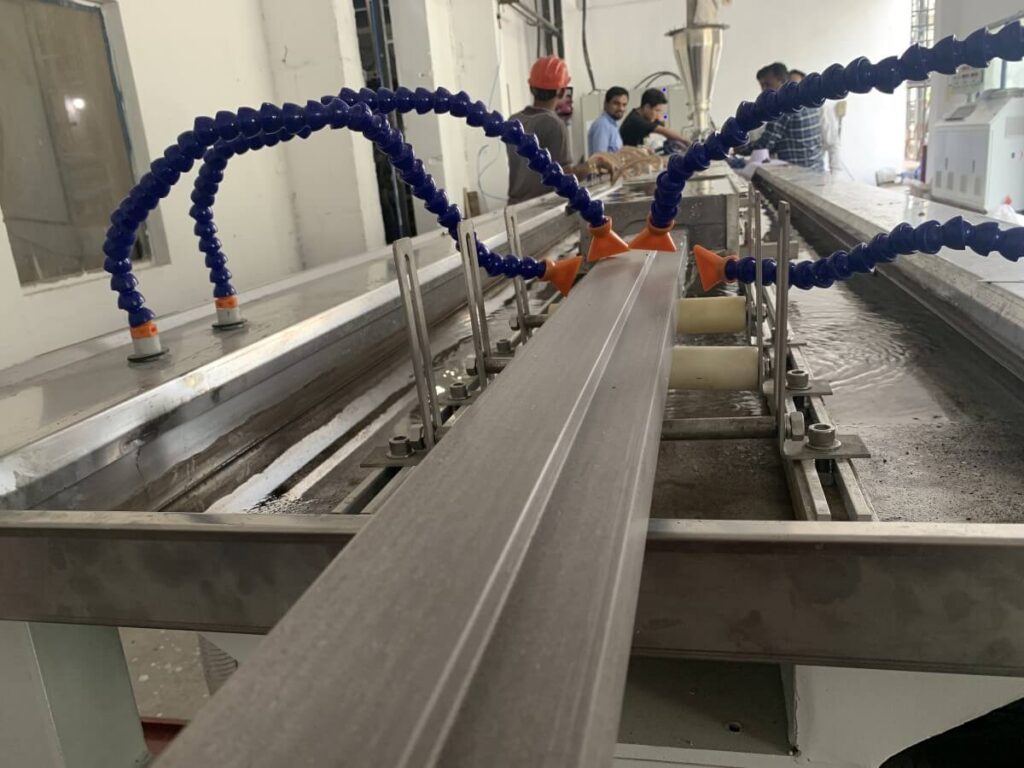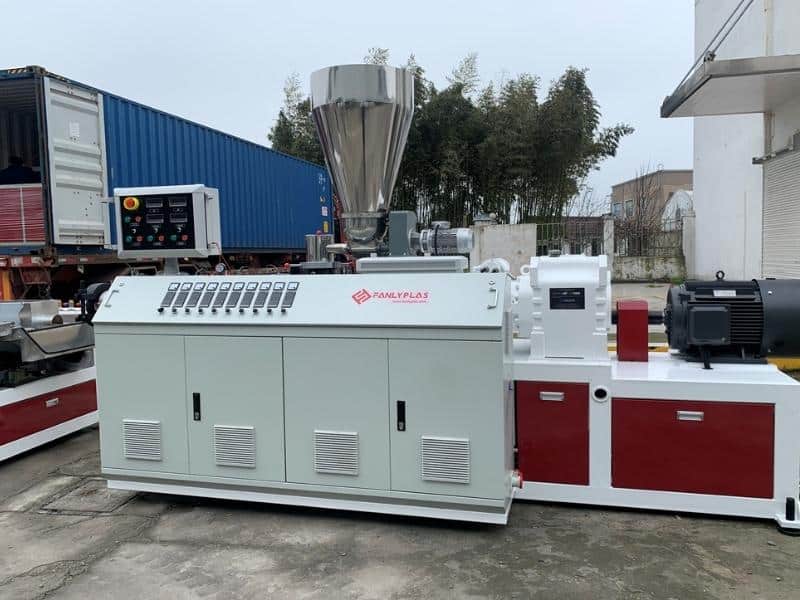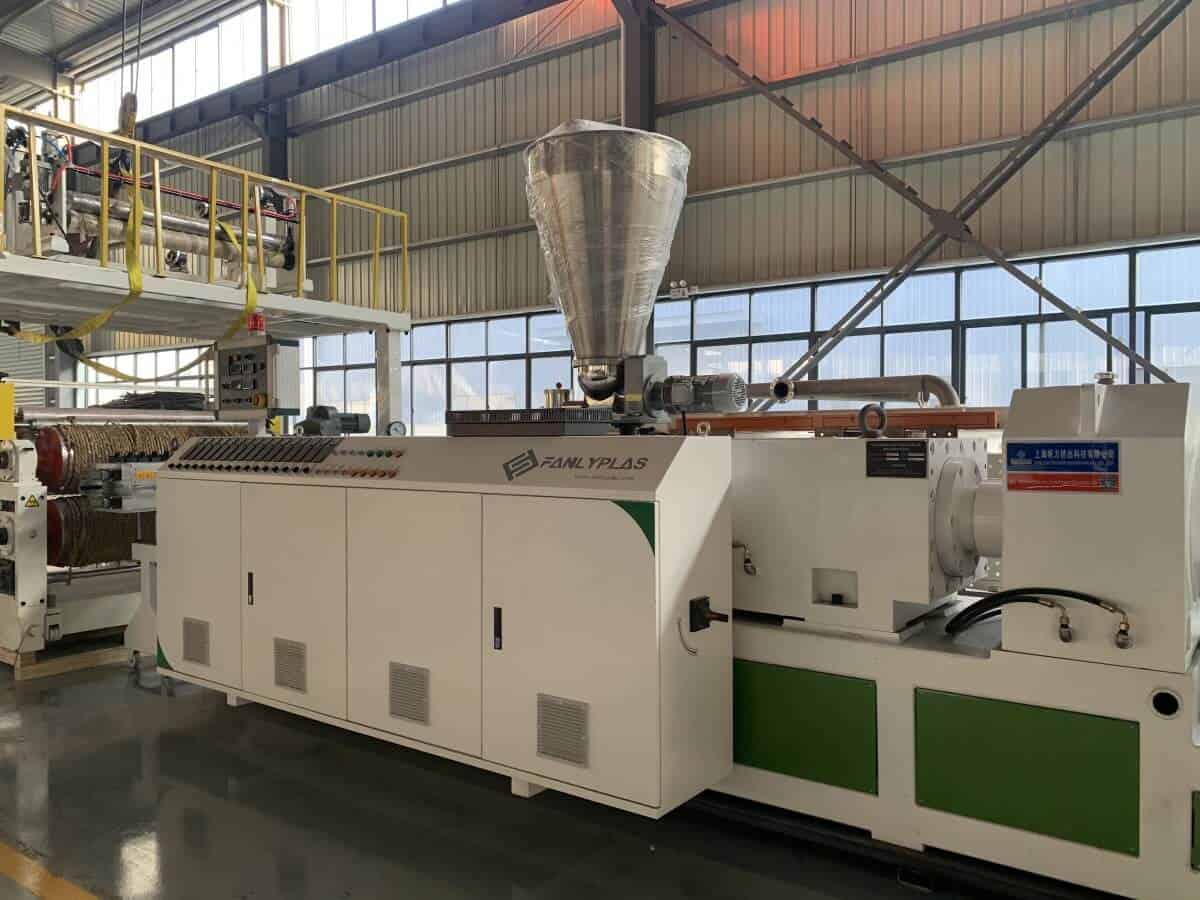Introduction
Purging involves the use of one material to get rid of another contaminative material from the surface of the PVC WPC door frame extrusion line. Likewise, purging encompasses cleaning the extrusion machine without the need to disassemble any of its components. The main goal of the process is to eliminate any resins that may be thermally or chemically unstable. Resins are contaminants that can limit the functionality of the extrusion machine and harm the quality of the output.
From a technical perspective, the purge compound is made up of a polymeric resin of high viscosity or molecular weight with processing temperatures that are relatively stable. There are different kinds of purging compounds with most of them containing fillers which help to scrub the extruder and flush out resins.
The beauty about purging is that it saves you the time and cost you would incur for taking the extrusion line apart and cleaning it manually. Similarly, the revolutionary cleaning method mitigates any oxidative or thermal degradation making it easy to restart the machine. Read on to understand more about how to purge your PVC WPC door frame extrusion line.

Purging procedure
Here is how the purging procedure goes:
- Confirm if the temperature in the barrel matches the process temperature of the purging compound d grade.
- Power the extruder ensuring that the material position is empty. This will allow for the cleaning of the feed throat and hopper. In the course of purging, you can leave the screens.
- Feed the purging compound into the empty extruder. The ideal purging compound capacity should be about two barrels.
- While feeding the purging agent into the barrel, it is important to observe the screw velocity or speed. Of course, begin at a relatively slow speed.
- Only increase the screw speed rate to a safer velocity after you observe some purging compound smoothly coming out of the head.
- Pull the screw to a stop the moment you notice the purging compound oozing out of the barrel. After that, allow the purging compound to linger within the barrel for a short while.
- Thereafter, start the screw rotation this time allowing it to run at top speed. In this manner, you will enable the screw to purge thoroughly until the moment all the purging compound flows out of the barrel completely.
- As the purging compound flows out of the barrel, manually inspect its lumps to check its texture and confirm the presence of contamination. If you notice a little contamination, you will have to redo the purging process a new. However, if you realize the purge is contamination-free, proceed to feed the processing resin into the extruder and run the screw at a safe speed.

Different kinds of purging compounds
Purging compounds clean the extrusion equipment by enabling material flow throughout the production line seamlessly. Likewise, they increase the volume of material in the extruder which enables the purge compounds to access the negative flow site and scrub out contaminants. Lastly, the purges emulsify pigments or impurities and place them in a state of suspension. Here are is a comprehensive explanation of different purging compounds:
1. Mechanical purging
Mechanical purging involves the use of stiff material or particles to clean the extrusion unit and release contaminative agents. Polyethylene is the most utilized mechanical purge material owing to its ability to work in different temperature ranges. High-density polyethylene is a superb mechanical purge compound known to highly effective and cheap. Glass-filled elements along with other abrasive minerals with low viscosity scour the die, barrel, and screw, forcing out any resins.
Surfactants are a good example of mechanical purging compounds. They easily penetrate the residue in the die, barrel, and screw loosening it as it disperses within the melt. You need to mix the surfactant evenly into the melt for optimal results. Another option is cast acrylic. It is an abrasive purging compound. It features a high melt viscosity and does not melt completely.
2. Chemical purging
As the name suggests, chemical purging compounds use specially formulated chemicals to clean the extruder. However, you need to soak the chemical purge into the extruder for up to 30 minutes for the compound to be effective. The only downside of this kind of purging material is the hefty prices that they bear.
On the bright side, chemical purges are super effective as they instantly attach contaminants and resins left on the surface of the screw, barrel, and other parts of the PVC WPC door frame extrusion line. Chemical purges work by plasticizing the resin in the extrusion machine. They reduce the viscosity of resin of the screw and barrel that enabling it to flow out of the barrel effortlessly. Similarly, the chemical additives trigger polymer depolymerization for components with lower molecular weight.
3. Liquid purging
Unlike other purging compounds, liquid purges do not utilize the traditional pellet-like material. Instead, they make use of chemical reactions which work to enhance material flow thus eliminating any resins that might be lodged onto the surface of the extrusion machine. They are closely related to mechanical purges but are mixed with carrier resins and then passed through extrusion lines.
Liquid purges trigger some form of turbulence within the extrusion barrel thus reducing material residence time in the extrusion unit. In the same way, liquid purging compounds cause an enhancement in the elimination of contamination. They also prevent any resins or toxic agents from hiding in negative flow sites where they can build up over a long time. Owing, to their heavily concentrated formula, this kind of purges is only supposed to be used in small amounts.
Importance of Purging
Mitigates Contamination
Contamination within the extrusion machine is dangerous. There are different types of contaminants including carbonized material that appear in form of black specs. The black specs often get lodged in barrel dead zones or on the extruder surface. Apart from that, contaminants may also come up as poorly melted resins, gels, and color streaks.
Not only will contaminants lead to corrosion and wear, but also poor product standards. Purging compounds are effective in eradicating any gels, color streaks, and carbon residue from the surface of the extrusion machine in the course of changeovers. With less contamination, there will be lower rejection rates for the final products. Most importantly, there will be fewer downtimes thus enabling the unit to churn out more door frames.
Lowers Downtime
Time is everything when it comes to producing PVC-based products. If the extrusion line works continuously with a top-notch production rate, it will be easier to meet customer demand and improve the brand. However, if the machine keeps breaking down frequently, it will be difficult to attain your production goal. Thus, purging minimized the time consumed in changing over resins. It also helps to eliminate contaminants that can harm product quality.
Cost-effective
Utilizing ideal purging compounds can be extra cost-effective. It helps to cut down the cost that might come with material wastage or scrap. In the same way, there will be no rejection from customers which will transform into affordable operational costs. Still, reduced contamination means reduced wear and lesser downtime owing to repairs. Finally, in comparison to manual cleaning, purging is time-saving and affordable.
Curbs screw pulls
The biggest advantage of purging is that you do not have to pull the extrusion machine apart for cleaning. You can still get rid of resins and other contaminants while the unit is intact. That makes the process relatively cheap and less time-consuming. Nonetheless, if you fail to purge the equipment accordingly, contaminants will stick on its surface limiting its functionality. Thus, you will have to clean it manually and that means actually pulling out the screw, barrel, and other vital parts.
Minimizes waste
Purging helps to get rid of colors or resins used in a previous production run. The move is important in curbing the final amount of waste or scrap produced. With most of the resins eliminated, the number of impurities will also be cut down considerably. Therefore, purging also boosts the efficiency and productivity of the PVC WPC door frame extrusion line.
Minimize rejection rates
Purging should be done after a long shutdown period or in the course of material change. Of course, careful purging removes toxins, plastics, and other contaminants that would otherwise compromise product quality. Products of poor quality will probably be rejected by potential customers. That is not good for the business. Yet, excellent machine purging ensures smooth production and smooth running of the business.
Choosing the best purging compound
I. Types of resin
The kind of resin being utilized in the process of door frame extrusion should be noted when choosing a purging compound. You need to be keener about the reaction of the resin under high temperatures. High-temperature resins such as LCP, PEI, and PEEK tend to degrade quickly if they stay in the barrel for long. When high-temperature resins have a longer residence time in the barrel, they begin sticking onto the surface of the screw.
If this happens for long, make use of a purging compound filled with glass or a high-temperature grade compound to clean the extruder. Remember, glass-filled purging compounds can be abrasive to sensitive surfaces. As a result, it is advisable to clean the extrusion line proactively if you do not want to utilize abrasive glass-filled purging compounds.
ii. Size of the extruder
When choosing a proper purging compound, you must keep the size of the extruder in mind. The size of the production unit will dictate the amount of purging compound you will utilize to clean it. You also need to consider the number of layers or extra lines the extruder has. If the machine has more layers and lines along with a bigger die or a bigger barrel, you will obviously require a colossal amount of purging compound. Regardless of the size of the extruder, it is always advisable to opt for more purging compounds than the estimated quantity. The extra volume should cover areas that are not cleaned perfectly.
iii. Operating temperature range
The temperature conditions under which the resins are processed have a significant impact on the purging compound grade you choose. Purging compounds are available in different grades depending on the operating temperatures. The grades might range from operating temperatures of about 320 degrees Fahrenheit all the way to 790 degrees Fahrenheit. Nonetheless, it is not only about the hotness of processing the resin. You need to know whether you will switch the resin temperatures from low to high or the other way around. Low-temperature resin demand E-grade purging compounds. On the other side, high-temperature demand purging compounds of grade PX2 or PF.
iv. Application
It is essential that purging compounds have varied cleaning applications based on their grade and resin processing temperature. Some purging compounds may require extreme scrubbing action while others do not. The best purging compound features clear instructions on how and when to use it. You need to know if the compound is ideal for use during color or carbon contamination. Apart from that, there are purging compound grades designed for use during low-residue and clear applications along with shutdowns or sealing,
v. Extruder problems
Prior to selecting an ideal purging compound, it is imperative to understand exactly what your extrusion line needs. Understanding the cleaning needs of the production line will help you select a proper grade to fix the problem. When there are contaminants in the extruder, the result is the presence of black specs or yellowed surfaces in the after product. You will also need to understand if your main goal is to simply get rid of previous resins. Only after comprehending problems in the extruder can you choose a perfect purging compound to clean it.
How to Reduce Purging Compound Residue
Purging compounds are meant to clean the extrusion line and get rid of all contaminants. However, some purging compounds might leave your production unit worse than it was before. Utilizing a wrong purging compound or using it in an improper manner might result in residue. Here are proven ways to eliminate purging compound residue:
Incorporate a compatible purging compound grade
It is crucial to adopt a purging compound grade that compliments the resin being processed. In this manner, very minimal residue will remain in the extruder. The resin determines the processing temperature. As a result, keep an eye on the melting index of the resin particularly if the purge compound seems to be stiffer than the resin.
Utilize a grade meant for lower residue
Incorporate a purging compound engineered for low-temperature or residue-sensitive resin in your extrusion equipment that experiences residue problems. Such purging compound grades work well when applied for use in lower residue. They can be utilized alongside other compatible grades when you aim to cut on the purging compound residue.
Use backpressure and high screw speed
In case your production line encounters residue-related problems when shifting production resins, the fault is associated with screw speed and low-to-medium backpressure. Certain types of resins demand decisiveness by means of backpressure and increased screw speed. The phenomenon may not be the same for heat-sensitive or sheer resins.
Conduct high-velocity injection air blasts
Most residue issues arise when resin and purge compounds hang up in the nozzle and ring areas. When the general purging exercise is complete, it is advisable to charge the equipment with a tiny amount of purging compound. Thereafter, perform brief high-speed injection air shots. The outcome of the high-pressure blast will force the purge compound directly into dead spots and tight surfaces that may be out of reach.
Switch to dark colors
It is prudent to alternate the colors to darker shades whenever the extrusion machine has resin problems. Residue from dark colors tends to be more visible as compared to residue produced by light colors. Consequently, dark colors are perfect at concealing the impact of the purging residue thus cutting on the purging duration.

FAQs About Purging PVC WPC Door Frame Extrusion Line
Why purge the extrusion line when you can regrind?
A lot of people may argue that a regrind is a better option as compared to purging. Moreover, regrinding is entirely free and will not attract any extra operational charges. Contrarily, it turns out that regrinding is actually ineffective in cleaning extrusion machines. Unlike most people believe, regrinding also comes with higher energy consumption. It is not cheap after all. The best way to clean the extrusion line is to purge it frequently during production and in the course of regrinding.
What is the essence of utilizing purging compounds?
As mentioned earlier, regrinding is not only energy-consuming but also time-wasting. Other cleaning methods such as flushing the extrusion unit with resin are plainly ineffective and material wasting. On the flip side, purging has proven to be effective in eliminating resins and removing contamination from the extruder. High-performing purging compounds like unicleanplus clean perfectly without leaving any resins behind.
Can purging compounds leave any residue behind? How can you remove it?
The ultimate purging material must be engineered to yield a low-residue compound. Low-residue compounds are perfect for different purging applications. It is an attribute that is crucial for soft and clear materials that tend to be sensitive to the residue. In the same way, it is prudent to opt for purging grades crafted to leave little to no residue in your extrusion machine. Another way to eliminate purging residue is to always follow a correct purging process.
Will abrasive material in the purging compound damage my machine?
Some purging compound grades come with rigid materials like glass to enhance their scrubbing and cleaning power. Nonetheless, the high scrubbing of rigid elements can be too abrasive hence damaging the surface of the extrusion machine. Mostly, abrasive materials trigger wear and tear. However, the concern about purging compounds being abrasive is not too bid. It is because purging compounds do not take long within the extruder.
The residence time of the glass-filled purging compound in the barrel or screw is too small and insignificant to cause wear and tear. Be that as it may, glass-filled grades and other purging compounds with rigid material are not recommended for cleaning components with surfaces that are extremely polished. In the same way, they are not good for surfaces with high precision clearance like extrusion gear pumps or highly textured components like the extrusion die.
What factors affect the effectiveness of a purging compound?
There are several attributes that impact the effectiveness of your purging compound. Of course, the purging procedure comes first. We have clearly outlined the purging procedure step by step. Failure to stick to the right purging procedure will limit its effectiveness. Apart from that, you should be keen about the purging compound quantity. It is vital to utilize the right amount. Using an amount that is lesser than the recommended quantity will surely yield mediocre results.
Likewise, using too much purging material could be harmful to the extrusion machine. Finally, the effectiveness of the purging compound relies on the type you incorporate in your cleaning exercise. There are different kinds of purging compounds out there. Yet, not every type will work for the PVC WPC door frame extrusion line. It would be prudent to test out different grades before choosing an ideal one.

Conclusion
Purging is an effective way to clean your PVC WPC door frame extrusion line from FANLYPLAS. Our company has the resources and experienced manpower to create world-class extrusion equipment. That aside, purging helps to curb contamination and amplifies productivity along with increasing up-time. Utilizing the right purging compound comes in handy when you have to optimize the operational efficiency of the extrusion line. We hope it will be easy to choose the right purging compound and use it accordingly to heighten the performance of your extrusion line.


